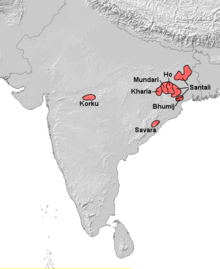Munda peoples
 Distribution of Munda language speakers in India | |
| Regions with significant populations | |
|---|---|
| India, Bangladesh | |
| Languages | |
| Munda languages |
The Munda peoples of eastern and central parts of the
History
According to linguist Paul Sidwell, pre-Munda languages arrived on the coast of Odisha from Southeast Asia about 4000-3500 years ago (c. 2000 – c. 1500 BCE),[1][2] during the late Bronze Age, at the time of decline of the Indus Valley Civilization in Northwest India. The Munda people spread from Southeast Asia and mixed extensively with local Indian populations.[3] Robert Parkin notes that the term "Munda" did not belong to the Austroasiatic lexis and is of Sanskrit origin.[4]
Austroasiatic DNA
Migration into India
According to Chaubey et al., "Austro-Asiatic speakers in India today are derived from dispersal from Southeast Asia, followed by extensive sex-specific admixture with local Indian populations."[7] According to Riccio et al., the Munda people are likely descended from Austroasiatic migrants from Southeast Asia.[8][9]
According to Zhang et al., Austroasiatic migrations from Southeast Asia into India took place after the last Glacial maximum, circa 10,000 years ago.[10] Arunkumar et al. suggest Austroasiatic migrations from Southeast Asia occurred into Northeast India 5.2 ± 0.6 kya and into East India 4.3 ± 0.2 kya.[11]
Tätte et al. 2019 estimated that the Austroasiatic language speaking people admixed with Indian population about 2000-3800 year ago which may suggest arrival of south-east Asian genetic component in the area. Munda-speaking people have high amount of East Asian paternal lineages O1b1 (~75%) and D1a1 (~6%), which is absent from other Indian groups. They found that the modern Munda-speaking people have about 29% East/Southeast Asian , 15.5% West Asian and 55.5% South Asian ancestry on average. The authors concluded that there was a mostly male-dominated migration into India from Southeast Asia. Modern people in Laos, Cambodia and Malaysia were found to represent the ancestral group, which migrated into India, and spread the Austroasiatic languages.[12] Munda peoples are genetically closely related to Mah Meri and Temuan people of Malaysia.[13]
Ethnic groups
- Asur people
- Bhumij people
- Birhor people
- Bonda people
- Didayi (Dire, Gta’) people
- Gadaba people (Only some Gadabas speak the Bonda-related Gutob language. Some others speak a Dravidian language.)
- Gorum (Parenga) people
- Ho people
- Juang people
- Kharia people
- Kodaku people
- Korku people
- Korwa people
- Munda people
- Sabar people
- Santhal people
- Sora people
Possible kins of the Munda peoples
Some ethnic groups do not natively speak any of the Munda languages, but genetic evidence suggest gene flow of some Munda genetic lineages.[14]
References
- ^ Sidwell, Paul. 2018. Austroasiatic Studies: state of the art in 2018. Presentation at the Graduate Institute of Linguistics, National Tsing Hua University, Taiwan, 22 May 2018.
- S2CID 204901974.
- ISBN 9781633239623. Retrieved 3 October 2019.
- ^ Parkin, Robert (1993). "Second Reply to Pfeffer" (PDF). University of Oxford. p. 161. Retrieved December 18, 2020.
The term 'Munda' is of Sanskritic origin and therefore not original in any sense to Austroasiatic speakers, although it has come to be used by one tribe as an alternative to their own term 'Horo' (Le. Roy's group; cf. Pfeffer above, p. 154; also Parkin 1990: 17, 23).
- ^ 崎谷満『DNA・考古・言語の学際研究が示す新・日本列島史』(勉誠出版 2009年)
- ISBN 9789027264640.
- PMID 20978040.
- S2CID 39428816.
- ^ The Language Gulper, Austroasiatic Languages
- PMID 26482917.
- S2CID 83103649.
- PMID 30846778.
- ^ "Scientists solve genetic puzzle surrounding Mundas". down-to-earth.org. 12 March 2019. Retrieved 13 August 2022.
- S2CID 7755962. "By considering the case of language shift we modelled the scenario considering Gond originally as an Austroasiatic population, which has recently changed its language to Dravidian. In this case, we should expect a largely similar amount of chunks donated by an outlier distant Austroasiatic population (Bonda) to Gonds and their present Austroasiatic (both North and South Munda) neighbours. However, this was not the case in our analysis, and we observed significantly higher Bonda chunks among North and South Munda neighbours than any Gond group."
External links
- http://projekt.ht.lu.se/rwaai RWAAI (Repository and Workspace for Austroasiatic Intangible Heritage)
- http://hdl.handle.net/10050/00-0000-0000-0003-66EE-3@view Munda languages in RWAAI Digital Archive


